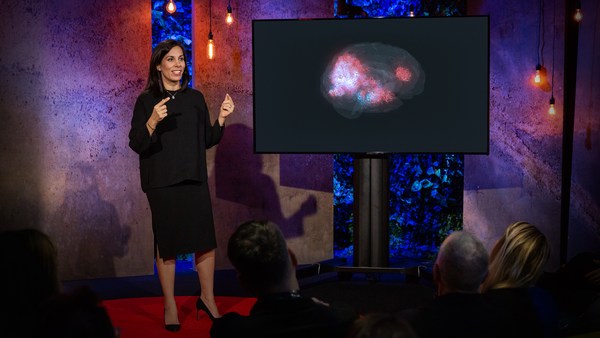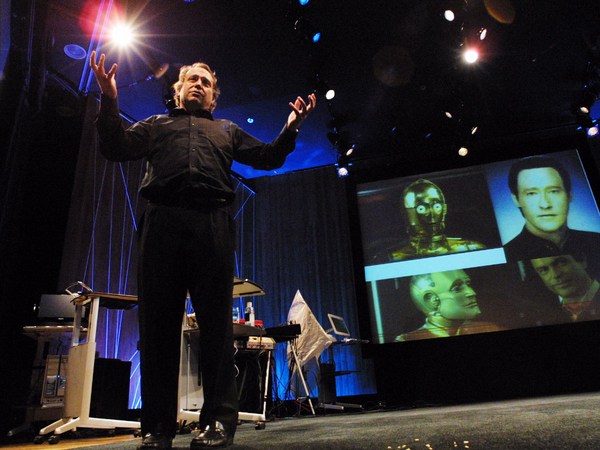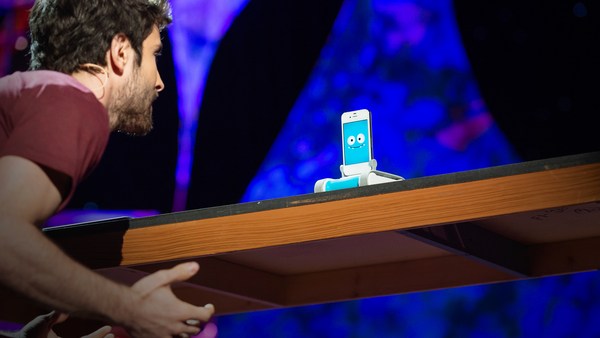Alex Luebke: I'd like to invite you to go on a fantastic voyage with me today, as we explore inside the human body. Inside each and every one of us holds mysteries and wonders that if unlocked, lead to better health, performance and longevity. But seeing inside has proven to be quite difficult.
Since the beginning of the modern era, the only way to really look inside was through rudimentary surgeries. Over the past 150 years or so, we've had great technologies that allow us to look from the outside, like X-rays and MRIs. But what I propose and what I'd like us to explore today is looking at microrobotics inside the human body.
As a first step on that journey, let me introduce you to PillBot. PillBot is a small, wireless robot that is remotely controlled, and it swims around in three dimensions in a water-filled human stomach. This robot has things you would expect on a robot. It has a camera, so it gives you a live video feed. It has control circuitry. It has LED lights because inside the human body it's quite dark. It has a wireless data link and it has a battery.
Now the way this robot moves is it has three pump jet thrusters that squirt water in six different directions, that allow the pilot to fly around in three-dimensional space in a water volume.
Over the past five years, we've spent a lot of time to get the size of this robot smaller and smaller.
What we started with wasn't quite --
(Laughter)
Not quite swallowable. But we finally worked our way down and where we are these days is about the size of a small multivitamin capsule.
(Applause)
Thank you.
Now we're going to fly this robot around for you for a little bit. But to do that, I would like to invite Doctor Vivek Kumbhari. He's the chairman of gastroenterology at the Mayo Clinic. And I'd like to have him pilot this PillBot while I turn it on.
(Applause)
Vivek Kumbhari: Here is a common scenario I encounter in my clinic. A patient who's generally in good health comes to see me because they have abdominal pain, and I suspect it's coming from the stomach. Now I need to understand precisely what the problem is, but I can't just pop my head in and take a look.
So, and despite that patient sitting right in front of me, I need to ask them to go back home and come back to the hospital on another occasion so I can put them to sleep with anesthesia so that they allow me to insert this long tube with a camera at the tip, through the mouth and into the stomach.
This is an endoscopy, and it's a relatively invasive and expensive procedure, and we are on a mission to do better. We'd like to transform this experience by dematerializing the physical hospital into PillBot.
As you can see here, we have a capsule here, and I'm using a game controller to navigate PillBot. Although I could have also used a tablet or a smartphone. You can move it around rather quickly here, and you can imagine that using the tank this size, we're still able to navigate the entire experience, which -- and this tank is significantly larger than the human stomach, or any internal human organ for that matter. I'm going to pause here while Alex is working on optimizing the robot.
AL: There we go.
(Laughter)
VK: So this is our goal. Be anywhere in the world. Whether you're at home, sitting on your couch, visiting space, or right here onstage at TED. What do you think, Alex? You should go ahead and swallow a PillBot?
(Applause and cheers)
So, as you can see, in just a few seconds, PillBot entered the stomach. So we're in the stomach now, and I'm carefully navigating around, looking for any changes in surface architecture that might represent an ulcer or a cancer, or any other pathology.
And I'm able to get very similar views as I would if I'd used a conventional endoscope. Now I'm able to see the entire stomach and revisit sites that piqued my curiosity.
And what could further improve this experience is if we used an augmented reality headset for 3D visualization of a stomach, or artificial intelligence for detection and characterization of an abnormality.
Now, fortunately for Alex, on this brief review, everything is looking normal here.
(Laughter and applause)
Though if there were a problem, being able to show and discuss with Alex in real time elevates his understanding of his health and is going to make him more compliant with therapy.
So now that we're done here, PillBot will take its natural course through and out the body.
(Laughter)
And fortunately for Alex, he'll have no awareness of this, and he won't have to retrieve this capsule.
(Laughter)
Now this robot was designed for the stomach, though the entire body needs this capability. Parts of the body, such as the colon, the heart and the brain should be made accessible with specialized robots that are just as easy to use.
I've dreamt of the day when I could explore the inside of the human body with robots, recognizing it would be an inflection point in my ability to help people live longer and healthier lives. Back to you, Alex.
(Applause)
AL: That was yummy.
(Laughter)
And no, you don't feel anything when the robot moves around inside you. It's quite, quite simple.
But think of that. How easy it was to get access to internal imagery anywhere. So that's going to allow us not only internal imagery, but also the diagnosis and the treatment that the doctor might be able to give. That's going to give us access to a vast amount of information that we can then use to train AI.
And with AI, we're going to be able to have it automate a whole variety of different functions, from performance improvement of the robot itself to autonomous control, where it actually flies around and maps out the entire interior surface of the stomach all on its own. That diagnosis and the treatment also comes along with that. And we train AI to help learn how to do that. And eventually, interventions.
Let's talk about a little bit where we want to go next. So the first thing we're going to do, we'll add some accelerometers on there, so it actually helps with that autonomous control. Also very interesting, we can start adding different sensors. So wherever the robot is going, we can go ahead and measure the health of what it's looking at right there. And as far as doing lab-on-chip capabilities where you can actually analyze the material right there in situ on the robot.
Imagine now being able to put different tools onto this, where you can cut and you can cauterize or inject medicine. Well, now you have a pill surgeon. And of course, you can have clusters of these robots that work together in unison to do complex procedures inside the human body.
To go even smaller, we actually have technology that exists today that allows us to make robots at the nanoscale, which now can bring robots anywhere in the human body, even into the human brain. And there's some phenomenal power sources that are available, coming online as well.
While PillBot is just about to go through clinical trials, it'll be a couple of years till it's on the market. There's a long way to go we still have to bring the full ability to do inner space exploration on us all. But it's a worthwhile journey to go on. Imagine being able to have all this information for you, for your health, for your family and for humanity.
So I'd like to invite all of you to join us in being brave. And let's bring microrobots inside the human body.
Thank you very much.
(Applause and cheers)





